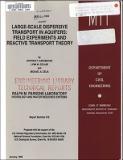| dc.contributor.author | Garabedian, Stephen P. | en_US |
| dc.contributor.author | Gelhar, Lynn W. | en_US |
| dc.contributor.author | Celia, Michael A. | en_US |
| dc.date.accessioned | 2022-06-13T13:13:24Z | |
| dc.date.available | 2022-06-13T13:13:24Z | |
| dc.date.issued | 1988-01 | |
| dc.identifier | 315 | |
| dc.identifier.uri | https://hdl.handle.net/1721.1/143063 | |
| dc.description | Supported by the U.S. Nuclear Regulatory Commission contract NRC-04-83-174. Supported by the National Science Foundation grant ECE-8311786. Supported by the U.S. Geological Survey grant 14-08-0001-A0460 | en_US |
| dc.description.abstract | A large-scale natural-gradient tracer test was conducted to examine the transport of reactive and nonreactive tracers in a sand and gravel aquifer on Cape Cod, Massachusetts. The movement and spreading of bromide, a nonreactive tracer, and lithium, a reactive tracer, were monitored over time using a three-dimensional sampling network and analyzed using spatial moments. Calculated total mass of bromide for each sampling date varied between 86 to 105 percent of the total injected mass. The lack of any trend in the calculated mass over time confirms conservative transport of the bromide ion. The horizontal displacement of the bromide center of mass followed a predicted velocity of 0.43 meters per day. During the early part of the test the bromide cloud sank rapidly due to the density difference between the native ground water and the bromide cloud. The bromide cloud moved more slowly downward during the later part of the test due to the accretion of recharge. A nonlinear trend in the bromide longitudinal variance with travel distance was observed during the first 40 meters of distance traveled, indicating the dispersion process was non-Fickian in the early part of the test. After 40 meters the longitudinal variance followed a linear trend, apparently reaching a Fickian limit. The longitudinal dispersivity, given by one-half the change in variance with travel distance, is about 0.96 meters. Transverse horizontal dispersivity is much smaller, about 1.8 centimeters, and transverse vertical dispersivity is even smaller, about 0.15 centimeters. The distribution and movement of the reactive solute, lithium, was strongly affected by adsorption to the aquifer sediments. The mass of lithium in solution showed a large decrease during the first 300 days of transport until about 10 percent of the injected mass remained in solution. The velocity of the lithium in solution was initially the same as bromide velocity (0.43 m/d) and then decreased to about 0.05 m/d after 300 days. The distribution coefficient for the lithium adsorption was estimated to be about 2.0 mL/g for the later part of the test. The change in longitudinal variance for lithium showed a strong nonlinear trend, concave upward, which in the later part of the test indicated a dispersivity ten times larger than that for bromide. In contrast, the values of the transverse horizontal and vertical dispersivities did not differ greatly from those for bromide. A theoretical analysis of reactive solute macrodispersion was developed to explain, in part, the enhanced spreading of reactive solutes relative to nonreactive solutes. The approach used in this analysis was to postulate correlations between hydraulic conductivity and both porosity and the distribution coefficient. Using a spectral analysis method it was found that longitudinal dispersivity can be significantly increased by a negative correlation of hydraulic conductivity to porosity and the distribution coefficient. It was also found that the effective retardation coefficient is the arithmetic mean. Although the theoretical analysis provides an explanation of the enhanced longitudinal mixing for lithium, the enhanced spreading of lithium could also be caused by a kinetically controlled reaction. | en_US |
| dc.publisher | Cambridge, Mass. : Ralph M. Parsons Laboratory, Hydrology and Water Resource Systems, Dept. of Civil Engineering, Massachusetts Institute of Technology | |
| dc.relation.ispartofseries | R (Massachusetts Institute of Technology. Department of Civil Engineering) ; 88-1. | |
| dc.relation.ispartofseries | Report (Ralph M. Parsons Laboratory for Water Resources and Hydrodynamics) ; 315. | |
| dc.relation.uri | https://hdl.handle.net/1721.1/14645 | |
| dc.title | Large-scale Dispersive Transport in Aquifers: Field Experiments and Reactive Transport Theory | en_US |
| dc.identifier.oclc | 18422860 | |
| dc.identifier.aleph | 659371 | |
